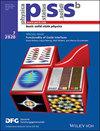过渡金属二卤化物异质结构中的层间激子磁谱学
IF 1.8
4区 物理与天体物理
Q3 PHYSICS, CONDENSED MATTER
引用次数: 0
摘要
过渡金属二掺杂化合物(TMD)单层是具有特殊自旋-谷耦合的直接隙半导体。将两种不同的 TMD 结合在一起可导致 II 型带排列和层间激子(ILE)的形成。在 MoSe2-WSe2 异质层中,只有当层间扭转角接近 0°(对齐,R 型)或 60°(反对齐,H 型)时,才能观察到光亮的 ILE。本文介绍了这些 ILE 在高磁场中的低温光学光谱研究。根据层间扭转的不同,ILE 转变要么是守谷转变,要么是不同谷之间的转变。这允许对 ILE g 因子进行工程设计,改变其大小甚至符号。此外,外加磁场会诱发 ILE 的谷极化,其积累可直接在激发和时间分辨光致发光中观察到,由于 ILE 光学选择规则取决于层间注册,因此具有特殊的特征。研究发现,对于 R 型和 H 型结构,在 24 特斯拉条件下,谷极化会发生共振增强,尽管它们的 g 因子明显不同。这一观察结果暗示了涉及 ILE 内单载流子和区界声子的散射过程。本文章由计算机程序翻译,如有差异,请以英文原文为准。
Magneto‐Spectroscopy of Interlayer Excitons in Transition‐Metal Dichalcogenide Heterostructures
Transition‐metal dichalcogenide (TMD) monolayers are direct‐gap semiconductors with peculiar spin–valley coupling. Combining two different TMDs can lead to a type‐II band alignment and formation of interlayer excitons (ILE). In MoSe2 –WSe2 heterobilayers, optically bright ILE are only observable if the interlayer twist angle is close to 0° (aligned, R‐type) or 60° (anti‐aligned, H‐type). Herein, low‐temperature optical spectroscopy studies of these ILE in high magnetic fields are presented. Depending on interlayer twist, ILE transitions are either valley conserving or between different valleys. This allows engineering of the ILE g factor, changing its magnitude and even its sign. Additionally, applied magnetic fields induce a valley polarization of the ILE, and its buildup can directly be observed in helicity‐ and time‐resolved photoluminescence, with peculiar features due to the dependence of ILE optical selection rules on interlayer registry. For both, R‐type and H‐type structures, it is found that at 24 Tesla, the valley polarization is resonantly enhanced, even though their g factors are markedly different. This observation hints at a scattering process involving single carriers within the ILE and zone‐boundary acoustic phonons.
求助全文
通过发布文献求助,成功后即可免费获取论文全文。
去求助
来源期刊
CiteScore
3.30
自引率
6.20%
发文量
321
审稿时长
2 months
期刊介绍:
physica status solidi is devoted to the thorough peer review and the rapid publication of new and important results in all fields of solid state and materials physics, from basic science to applications and devices. Being among the largest and most important international publications, the pss journals publish review articles, letters and original work as well as special issues and conference contributions.
physica status solidi b – basic solid state physics is devoted to topics such as theoretical and experimental investigations of the atomistic and electronic structure of solids in general, phase transitions, electronic and optical properties of low-dimensional, nano-scale, strongly correlated, or disordered systems, superconductivity, magnetism, ferroelectricity etc.

 求助内容:
求助内容: 应助结果提醒方式:
应助结果提醒方式:


